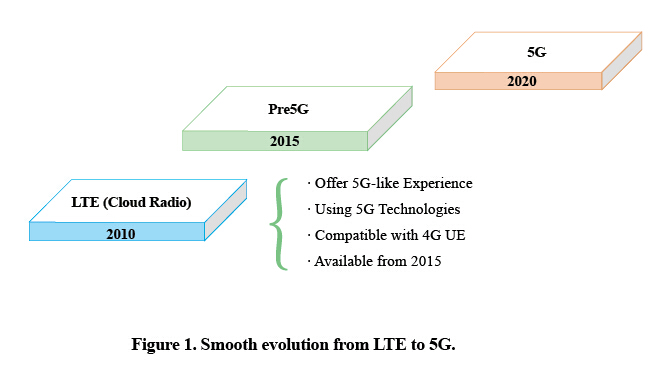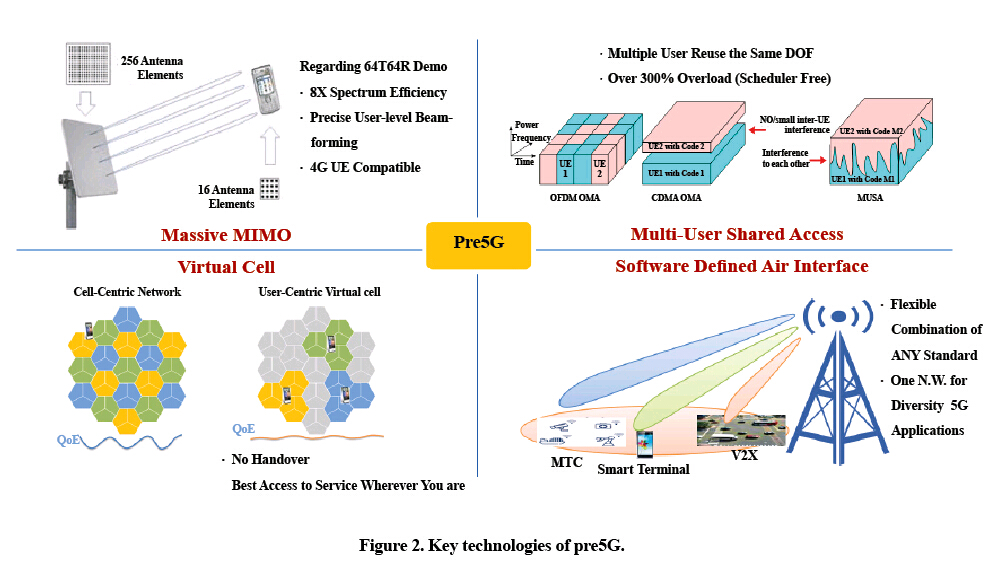Smooth Evolution to 5G
4G is being commercialized worldwide, and research on 5G is already in full swing. According to the ITU, 5G will be launched commercially after 2020. Whether or not LTE networks can meet the increasing demands for data services within the next five years is a big concern for operators.
ZTE proposed a cloud radio solution based on 4G access networks and mainstream mobile bearer as early as 2012. This solution suppresses interference on LTE networks and exponentially improves network performance. It enables smooth, consistent access far beyond that for 4G users on LTE networks. So far, cloud radio has been commercially used by China Mobile Quanzhou and Tianjin, China Telecom Shijiazhuang, and Hong Kong CSL. It has greatly improved the access experience of 4G network users, especially the users at cell edge.
ZTE has focused on the core demands of mobile operators in the coming years and has proposed a pre5G concept that uses the most practical 5G core technology to provide users with a 5G-like experience. This solution is backward compatible with commercial LTE UEs and will be in commercial use before 2020. By utilizing an operator’s existing sites and spectrum resources, the access rate of existing network users and overall network capacity can be greatly improved. This eases the challenges associated with surging data traffic in the period prior to 5G standardization and helps mobile operators evolve smoothly to 5G (Fig. 1).

From technical perspective, pre5G encompasses massive MIMO, virtual cells, Multi-User Shared Access (MUSA), and software-defined air interfaces.
As one potential 5G core technologies, massive MIMO can use 100 or more antennas, which is one order of magnitude higher than that used by traditional base stations. Consequently, massive MIMO transmits more independent data steams between systems and UEs to increase spectrum efficiency. Simulation results show that the throughput of a massive MIMO base station with 128 antennas (64 independent channels) can be six to eight times that of a traditional two-antenna base station. Massive MIMO enables an operator to meet growing demands for data services with existing sites and spectrum. Even if commercially used 4G UEs could not support multi-antenna technology, massive MIMO base stations can increase the overall capacity of systems through multi-user MIMO.
Also, by achieving accurate 3D beamforming and user tracking, massive MIMO significantly improves network coverage and reduces interference with neighboring base stations. Massive MIMO can be used in complicated wireless environments (Fig. 2).

Virtual cells turn traditional cell-centric mobile access networks into user-centric access networks. Each user that accesses the network has an associated virtual cell comprising several neighboring physical cells of the user. These physical cells coordinate with each other to serve the user. When the user moves within the network, the physical cells contained in the virtual cell change, but the virtual cell ID remains the same. Because there is no handover when the user moves, the user always has good coverage and the best access services from multiple neighboring physical cells. Virtual cells are a revolution in mobile access. Instead of users finding Networks, networks chase users.
3G CDMA uses code domain orthogonality and 4G OFDM uses sub-carrier orthogonality to avoid interference between users. However, the system access capacity is constrained by orthogonality. By leveraging users’ transmit power differences, MUSA applies non-orthogonal complex spreading sequences at the transmitter for data modulation as well as successive interference cancellation algorithms at the receiving end to filter out interference and restore user data. It also allows multiple users to reuse the same degree of freedom (DOF) of an air interface to improve system resource multiplexing. In addition, there is no need to guarantee orthogonality between users or guarantee the scheduling mechanism of air interfaces. This is ideal for high-density, high-capacity mobile access scenarios. Theoretical simulations show that ZTE’s MUSA algorithms can increase the overload capacity of wireless access networks by more than 300% so that the demand for Internet of Everything (IoE) can be met.
In the 5G era, diverse services have different requirements in terms of access network performance. For smart terminal users, equal importance is given to both access rate and mobility. For Internet of Things applications, massive access capacity, efficient low-rate data forwarding, and low power consumption are core demands. For Vehicle to Vehicle application, especially autopilot applications, low latency is very important. If dedicated access systems are deployed for different types of applications, 5G networks will become too complicated, and O&M costs will be too high. Therefore, ZTE proposed software-defined air interfaces (SDA) that uses a high-performance mobile access network infrastructure to satisfy all the needs of a variety of services. This simplifies 5G access network architecture and saves network construction and O&M costs.
In November 2014, China Mobile and ZTE jointly completed pre-commercial testing of the world’s first TD-LTE massive MIMO base station in Shenzhen. ZTE’s latest 64-port/128-antenna massive MIMO base stations were used, and the test was initiated and organized by China Mobile Research Institute (CMRI). The results far exceeded CMRI’s expectations.
ZTE’s massive MIMO is well-designed in terms of size, weight, cost, engineering, and installation for commercial use. Pre-commercial massive MIMO products integrate 128 antennas into a module with a similar windward area as that of an 8-antenna module. This highlights ZTE’s strong R&D and commercial capabilities in the field of 5G.
Huang Yuhong, vice president of CMRI, said, “ZTE has completed a 3D/Massive MIMO pre-commercial field test successfully. Both the progress and results are encouraging. It accelerates the pace of technology commercially proven, and deeply explores the technical advantage of TDD networks. China Mobile will enhance its partnerships with ZTE in 3D/Massive MIMO and other 5G technologies.”
Xiang Jiying, ZTE’s CTO of wireless products, said, “It seems impossible to have a 3D/massive MIMO base station with 100+ antennas, one order of magnitude higher than that at traditional base stations. However, ZTE has made the seemingly impossible 5G technologies happened in the 4G era. We know people are concerned about size, but the tests indicate that the size of a 3D/massive MIMO base station is the same as that of an eight-antenna one. ZTE’s pre5G concept and technology innovation enables 5G technology-based service experience brought by 3D/massive MIMO on the 4G UEs.”
Dr. Liu Guangyi from Wireless Technology Research Department of CMRI said, “The test boosts our confidence in launching 3D/massive MIMO, accelerates the expected process significantly, and allows us to explore new applicable scenarios of 3D/massive MIMO.”
As a major provider of wireless products and solutions, ZTE is committed to innovative products and solutions. The successful pre-commercial test of massive MIMO further displays ZTE’s strong research focus, capability in 5G key technologies, and practices ZTE’s Pre5G business philosophy.